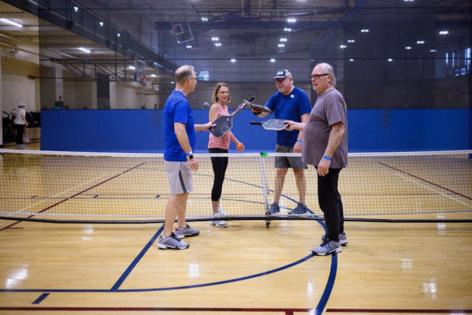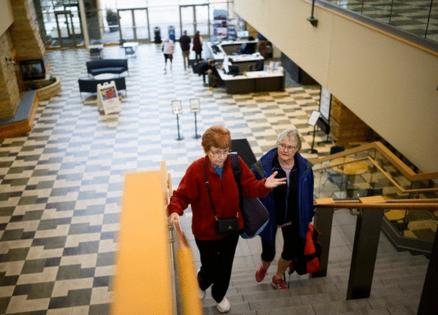As suburbs age, cities ponder the future of their community centers
Published in Senior Living Features
MINNEAPOLIS -- Twin Cities suburbs that boomed in the 1990s built shiny new community centers as a place for residents, ranging from teens and young families to seniors, to congregate and be active.
Three decades later, many of those facilities are aging and outdated. Across the metro, city leaders are pondering the same question: At a time when the cost of basic services is rising, are these community spaces, with their massive indoor playgrounds, gymnasiums, pools and event spaces, still worth the investment?
For several cities, the answer is clearly yes. Among them: Apple Valley, Chaska, Eagan and Maple Grove, which are all making plans to upgrade their community centers or already doing it, with price tags from $10 million to $116 million.
"It's a great symbol of what a community can be to have these spaces where people can be comfortable and gather," said Chuck Stifter, Maple Grove's parks and recreation director.
Other communities have made different calculations after crunching the numbers for long-term operational costs.
After a 2018 study found that Rosemount would lose $500,000 annually running a community center, officials "pretty quickly abandoned the idea," said City Administrator Logan Martin. Instead, the city is helping Life Time Fitness with some construction costs; the city owns the building and the land the fitness center sits on.
Several city officials compared the facilities to parks and libraries — public spaces that aren't supposed to turn a profit but enrich residents' lives.
City officials must choose whether to fill potholes, tackle affordable housing or invest in civic centers, said Edward Erfurt, director of community action for Strong Towns, a nonprofit dedicated to helping cities become financially resilient. The centers can help communities come together, which is important, and can have benefits like reducing youth crime.
"Every investment we make on a municipal level, these are promises that we make in the moment as an elected body," Erfurt said. "The struggle is, long term, the sustainability of these systems."
Cities often must cobble together funds from multiple sources to build or upgrade its community center.
At least 15 cities across Minnesota are asking this year for state bonding money to construct or refurbish community centers, including Maple Grove, Alexandria, Le Seuer and Duluth. Several city officials said they're responding to demand from their own residents and those of neighboring cities for such spaces.
Maple Grove will use sales taxes, state bonding money and a youth athletics partnership to fund its ambitious $116 million remodel. The project will include a third sheet of ice, a senior center expansion, new banquet facilities and renovations to two pools. The city received $6 million in bonding money for design work previously and is now seeking $16.5 million more.
"The market is still high for this type of thing," Stifter said. "I think [community centers are] as relevant as they've ever been."
Plymouth, which undertook a $49 million renovation and expansion of its community center — including a walking track, indoor playground, dance and fitness studios and art gallery — funded it with money from the state, city-issued tax abatement bonds, a sales tax exemption and a previous levy. It opened in 2022.
The city had over a half-million visitors last year and sold about 55,000 indoor playground daily passes. "Our attendance just keeps going up and up," said Kari Hemp, the city's recreation manager.
But the costs are ongoing. Plymouth subsidized the facility by about $740,000 in 2023, Hemp said, adding that it's a service and officials know they won't break even.
"Very few [community centers] make money; often they're subsidized by taxpayers in some way," said Nancy Blankfard, an HGA architect who designed the Plymouth renovation. "In smaller communities ... it's really hard to imagine how they can pay for a large community center."
Andrew Pimental, Eagan's parks and recreation director, said some return on investment is important. The city is planning a community center renovation for approximately $10 million and recently conducted a study to determine whether there were additional ways it could bring in money.
"It's a balance of really trying to find that middle ground where you're recovering your costs but also making sure you're offering good, quality programs," Pimental said.
About 20% of the Eagan center's annual operating cost is covered with revenue from several city-owned antennas.
Some cities see little alternative to keeping up their community centers. Fall behind, and they might lose out when people are deciding where to live.
Apple Valley is spending $10 million to build an indoor playground and fitness space in between its current community center and senior center, part of a $73 million parks referendum passed last year.
"We wanted to make sure the amenities that Apple Valley is able to provide to the public are in line with some of our surrounding communities," said Eric Carlson, the city's parks and recreation director.
While large suburbs with strong tax bases can afford to dream big, a new or revamped community center may appear out of reach for other communities.
Brooklyn Center leaders hope for a bigger, better community center, as their current structure is over a half-century old. The $37.5 million price tag, though, is an obstacle for a city of 34,000 where residents have one of the lowest average incomes per capita in Minnesota, said Cordell Wiseman, parks and recreation director.
The city's plan calls for four gyms, an indoor track and indoor play area and a teen center. Brooklyn Center received $5.1 million from the state and will ask voters to approve a 0.5% sales tax in November to pay for it.
"If it passes in November, it's going to be a huge deal for our community," Wiseman said. "Our youth and our young adults pretty much have nowhere to go."
Officials said they believe they can come out $100,000 ahead of annual operating costs by hosting events and tournaments at the revamped facility. But City Council Member Dan Jerzak voted against putting the sales tax question on the ballot. "I don't believe we have the bandwidth to financially afford this," he said.
Some cities have gotten creative to keep their centers afloat. The Maplewood Community Center was losing $300,000 to $500,000 per year before the city turned over operations to the YMCA in 2016. Now, the city is responsible for exterior building maintenance and the YMCA does everything else, making it a "win-win" for everyone, said Melinda Coleman, Maplewood's former city manager.
In West St. Paul, the city was left without a community center when the YMCA closed in 2019. Officials recently discussed results of a survey, conducted with neighboring Mendota Heights, that gauged demand for a community center. A previous proposal estimated a midsize community center would cost $40 million to $60 million.
Mayor Dave Napier said figuring out "the threshold of subsidy from the community" may determine whether one is built in West St. Paul. He noted the camaraderie he sees when he brings his grandkids to community centers to play, with birthday parties and neighbors waving hello.
"In a perfect world, we would have a community center," he said.










Comments